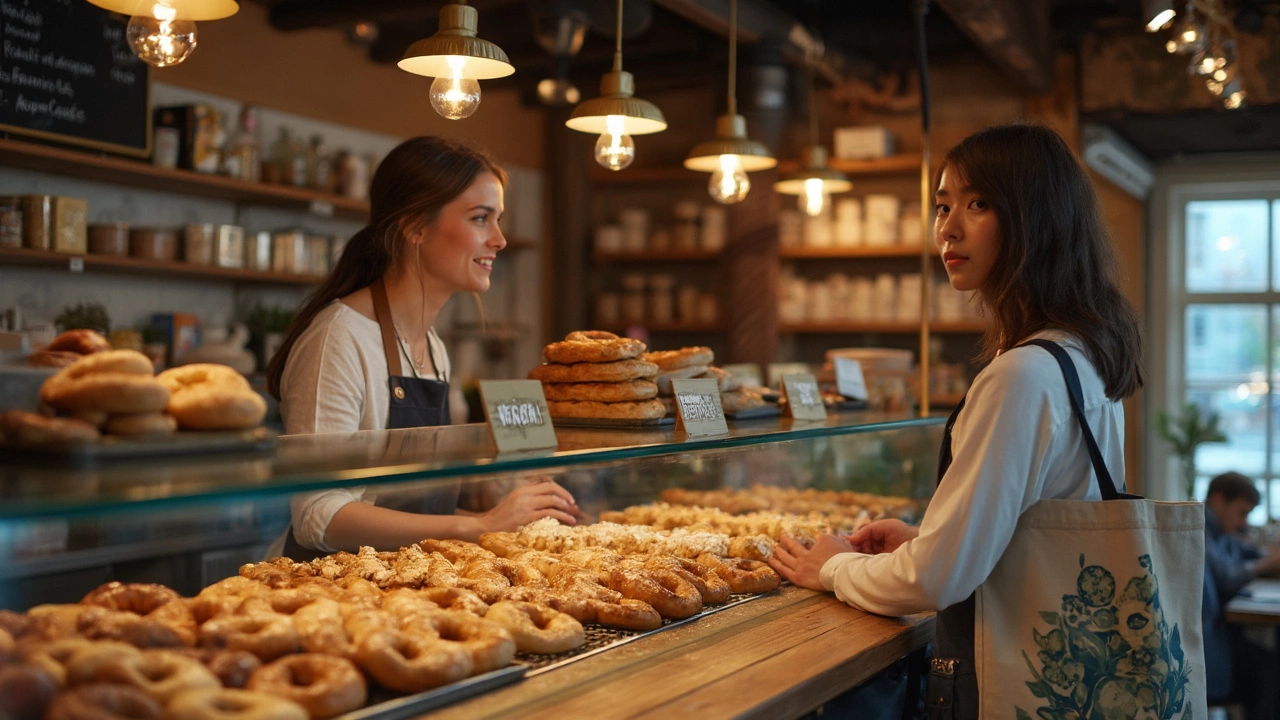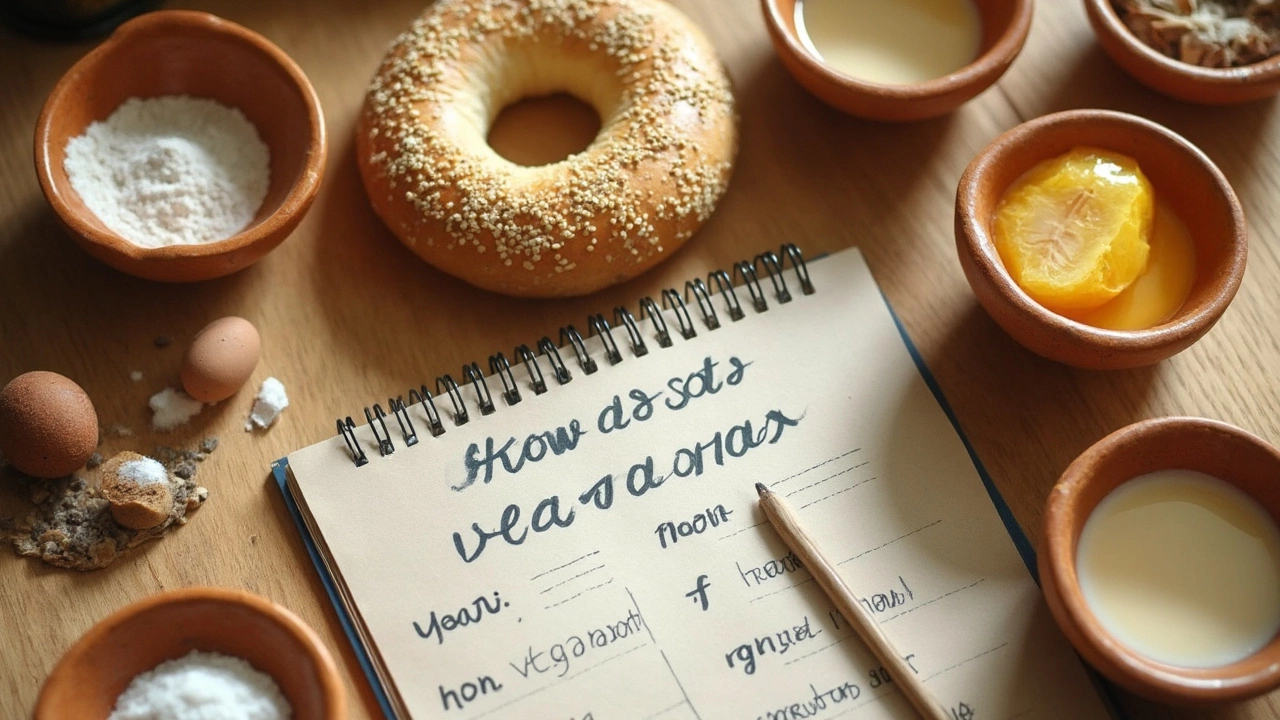
You’d think a bagel would just be bread, right? Maybe a little flour, water, yeast, done. But if you’ve ever tried ordering a bagel as a vegan, you know it’s not always that simple. Sometimes dairy or eggs sneak into the mix, and they don’t always make it obvious on the ingredient list.
If you’re plant-based or trying to avoid animal products, it seriously pays to check what goes in. Traditional New York-style bagels are usually just flour, water, yeast, salt, and maybe a bit of malt syrup. No milk, no butter, no eggs. Unfortunately, modern recipes can play fast and loose with the rules—brioche-style bagels, egg bagels, and shiny bakery varieties often slip in some non-vegan stuff like honey, milk powder, or egg wash.
The good news? There are plenty of bagels that are already vegan, even at regular grocery stores. But don’t just trust the label. Always flip over that package and double-check the ingredients. Even something like "enriched flour" could have those hidden additives. If you’re grabbing a fresh bagel from the bakery, just ask! Most staff know what goes in their dough (but if they don’t, that’s a red flag for any allergy or vegan eater).
- What’s Actually in a Bagel?
- Common Animal Ingredients to Watch For
- How to Find or Make Vegan Bagels
- Best Vegan Bagel Toppings and Dessert Ideas
What’s Actually in a Bagel?
The classic bagel recipe is surprisingly simple. Traditional New York-style bagels use just five ingredients: high-gluten wheat flour, water, yeast, salt, and a little bit of barley malt syrup or sugar for flavor. That’s it. If you’re lucky, those are the exact bagels you find at a neighborhood bakery—it’s the no-nonsense base that gives bagels their chewy, satisfying bite.
Where things get tricky is when recipes start adding extras. Some bagels found at stores and cafes try to be fancier or bigger, and they sneak in stuff that isn’t on every vegan's approved list. Here’s a look at what a typical bagel might contain:
- Flour – Usually wheat flour. Sometimes it’s enriched, which is generally still vegan, but always double-check.
- Water – No surprises here.
- Yeast – This is the leavening agent, and yeast is vegan-friendly.
- Salt – For flavor.
- Malt syrup or sugar – Barley malt syrup is most common and usually vegan. Some places swap in honey, which isn’t vegan, so watch out for that.
Modern or grocery store bagels can add things like:
- Eggs (especially in ‘egg bagels’ or anything yellowish like challah-style)
- Milk, butter, or cream (some bakery bagels add dairy for tenderness)
- Honey (sometimes found in "honey wheat" or as a subtle sweetener)
- L-cysteine (a dough conditioner now usually made from synthetic sources, but it’s worth checking since it used to come from feathers)
If you’re a serious label-checker or have allergies, skimming the nutrition facts isn’t enough. Peek at the full ingredient list. Here’s a quick cheat sheet of common vegan and non-vegan bagel ingredients:
| Ingredient | Usually Vegan? |
|---|---|
| Flour | Yes |
| Water | Yes |
| Yeast | Yes |
| Salt | Yes |
| Barley malt syrup | Yes |
| Honey | No |
| Eggs | No |
| Milk/Butter | No |
When in doubt, don’t assume a bagel is vegan just because it looks plain. Bakeries change recipes unexpectedly, and bagel shops sometimes use shiny egg wash to make the crust look extra golden. Always ask how their bagels are made, and if you bake at home, you’re totally in control of what goes in.
Common Animal Ingredients to Watch For
Checking labels is a must if you want to make sure your bagels are actually vegan. Some animal ingredients pop up in places you wouldn’t expect. Here’s what you need to watch out for, especially if you’re shopping or grabbing a quick bite from a café.
- Eggs: These are common in “egg bagels,” challah-style bagels, and sometimes in shiny or golden-topped bagels. Look for words like “egg wash” or “enzymes”—yep, those can mean eggs snuck in.
- Milk & Dairy: Milk powder, butter, and whey (a milk protein) often get tossed into commercial bagels for a softer texture. Even if you don’t see straight-up “milk” on the list, scan for casein, lactose, or cream cheese flavorings.
- Honey: Sweet, but not vegan. Sometimes, honey replaces sugar or malt syrup, especially in “healthy” or “natural” bagels. Some brands even add it for color.
- L-cysteine: This one is sneaky. It’s sometimes used as a dough conditioner and can be made from animal feathers or hair. It’s rare, but it does pop up in some mass-produced bagels.
- Enzymes: You’d think enzymes are harmless, but some are animal-derived. Food makers aren’t required to say what type, so if you see “enzymes” on the label and nothing says “vegan,” be cautious.
Here’s a quick cheat sheet for common animal-based add-ins and what to watch for:
| Ingredient | Possible Label Wording |
|---|---|
| Eggs | Egg, egg wash, albumen, enzymes |
| Milk/Dairy | Milk powder, butter, whey, casein, lactose |
| Honey | Honey, honey flavoring, natural sweetener |
| L-cysteine | Dough conditioner, L-cysteine |
| Enzymes | Enzymes (unspecified) |
One more pro tip: Some bagel stores brush their bagels with butter or egg after baking to get that tempting shine. Always ask how that golden crust is made if you’re out at your favorite bakery. If the staff can't give a clear answer, play it safe and choose another option or go for a plain one that’s less likely to contain hidden animal ingredients.

How to Find or Make Vegan Bagels
If you’re on the hunt for vegan bagels, knowing what to look for is half the battle. Most big grocery chains actually stock a few brands that are vegan by accident—think Thomas’, Dave’s Killer Bread, or some local store brands. Check the packaging for ingredients like egg, milk, honey, whey, or casein (all off-limits if you want a 100% plant-based bagel). The good news is, plain, everything, sesame, and poppy seed bagels are often the safest bets. Watch out for flavors like cheddar, blueberry, or cinnamon raisin, which sometimes have sneaky dairy.
Bakeries can be a little trickier. Always ask if their bagels have egg wash or honey in the glaze. If you’re not sure, just explain you’re looking for a dairy-free or egg-free option. Most modern bakeries use digital recipes, so their staff can usually pull up an ingredient list in seconds. Another tip: if you see “egg bagel” on the menu, that’s a hard no. But traditional water bagels or Montreal-style bagels can be vegan, depending on the recipe.
Want to avoid the guesswork? Making vegan bagels from scratch at home is way simpler than people think. You only need a handful of basic pantry items:
- Flour (bread flour works best, but all-purpose is fine too)
- Instant yeast
- Warm water
- Sugar or maple syrup
- Salt
The process is straightforward:
- Mix the yeast, sugar, and warm water. Let it froth up (it takes about 5 minutes).
- Add flour and salt, then knead until it’s smooth. Let the dough rise for about an hour.
- Shape into bagels, boil each one for 45-60 seconds per side (boiling gives them that signature chew), then bake in a hot oven until golden.
Even better, you can season them however you like. Toss on sesame seeds, everything seasoning, or even vegan cinnamon sugar before baking. This way, you know every single ingredient is plant-based.
Surprisingly, a 2023 survey of major US supermarket chains showed about 68% offer at least one “accidentally vegan” bagel flavor on their shelves. This is great news if you’re looking for more dairy-free and vegan desserts in your routine.
Bottom line? Both finding and making vegan bagels are totally doable. Once you get the hang of label-reading—or start baking your own—it’s easy to make bagels part of your go-to vegan breakfast or dessert lineup.
Best Vegan Bagel Toppings and Dessert Ideas
Topping a vegan bagel isn't just about avoiding cream cheese. There’s a whole lineup of plant-based spreads and combos that make a plain or toasted bagel into a real treat—even a dessert. Seriously, the world of vegan desserts and breakfast collides right here.
- Peanut butter and banana slices: The classic. Add a sprinkle of cinnamon or drizzle a little maple syrup for extra flavor.
- Dairy-free cream cheese: There are lots of brands now—Follow Your Heart, Kite Hill, and Violife are all good picks. Plain is great, or go wild with chive, everything, or even strawberry flavors.
- Vegan chocolate hazelnut spread: Yep, this exists. Try Nocciolata Dairy Free or make your own with cocoa and almond butter.
- Fresh berries and agave syrup: Blueberries, strawberries, or raspberries pair well with any slightly sweet bagel.
- Vegan lemon curd: Tangy, sweet, and perfect on a toasted bagel for dessert vibes.
- Coconut yogurt with granola: Layer it up kind of like a parfait on a warm bagel half.
- Apple butter or pumpkin butter: Smooth, sweet, and usually just fruit and spices.
- Avocado and everything bagel seasoning: Okay, not a dessert, but too good not to list—and totally vegan-friendly.
Ever considered dessert sandwiches? Slice your vegan bagel in half, fill with vegan ice cream, and roll the edges in chopped almonds or chocolate chips. Pop in the freezer for an hour and you’ve got a simple homemade vegan ice cream sandwich.
Want some ingredient inspiration? Here’s a quick look at vegan-friendly toppings you can find at most grocery stores:
| Topping | Popular Brands | Flavor Notes |
|---|---|---|
| Dairy-Free Cream Cheese | Kite Hill, Violife, Tofutti | Plain, chive, garden veggie, strawberry |
| Chocolate Hazelnut Spread | Nocciolata Dairy Free, Nutiva | Rich, chocolatey, nutty |
| Fruit Preserves | Bonne Maman, Crofter's | Berry, apricot, orange |
| Nut Butters | Justin's, Trader Joe's, 365 | Peanut, almond, cashew |
Remember, most plain, sesame, and everything bagels are vegan, but double check before loading them up. With all these options, skipping the dairy doesn’t mean missing out on delicious toppings or sweet treats!